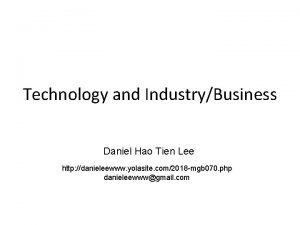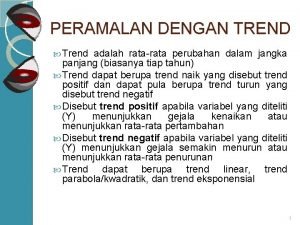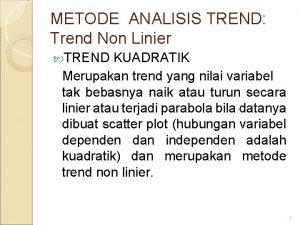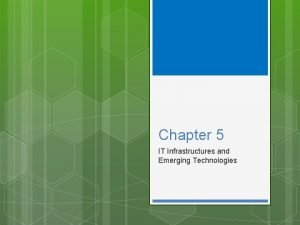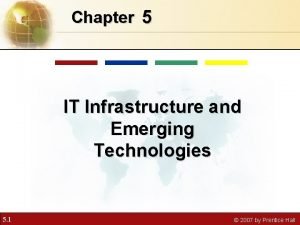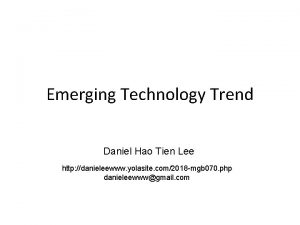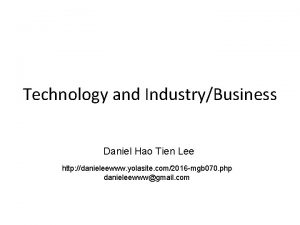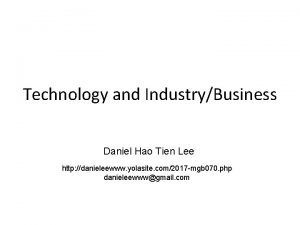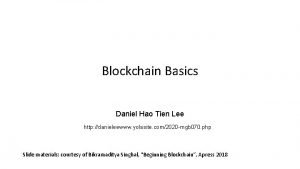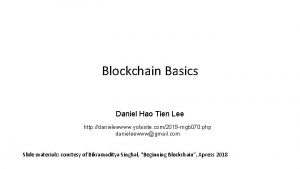Emerging Technology Trend Daniel Hao Tien Lee http








- Slides: 8

Emerging Technology Trend Daniel Hao Tien Lee http: //danieleewww. yolasite. com/2020 -mgb 070. php

Top Technology Trend • https: //www. youtube. com/watch? v=6 Hzd. Ok. P PPRU • https: //www. youtube. com/watch? v=s 6 Lr. Bex 9 NPA

https: //www. gartner. com/en/publications/top-tech-trends-2020

What AI Can and Can’t Do: Replacement of Cognitive Labor "AI Super-Powers, China, Silicon Valley, and The New

What AI Can and Can’t Do: Replacement of Physical Labor "AI Super-Powers, China, Silicon Valley, and The New

Post AI Era • Symbiosis between Human and AI-Machine! – How – https: //medium. com/@kaifulee/10 -jobs-that-aresafe-in-an-ai-world-ec 4 c 45523 f 4 f – https: //www. inc. com/jessica-stillman/21 -futurejobs-robots-are-actually-creating. html • …. .

Assignment for Debate(10/08) • Resolution of “The population is ready for Artificial Intelligence” – Argument # 1: Taxing both A. I. Robot and A. I. Automation could ease social inequality issues – Argument # 2: Universal Basic Income for digital economy can improve social unstable – Argument # 3: AI/ML(machine learning) in education should close the gap on income inequality – Argument # 4: AI dominant society should preserve humanity and amplify human potential in the long run – Argument # X’s: (to be determined by the teams) • Arrangement: For(teams 1/3), Against(teams 2/4), Organizer(Wayne), Commentator(Daniel)

Informal Debate Guidelines • Conducting: (hosted by Organizer) – The first speaker on the For (affirmative) team presents arguments in support of the resolution. (3 -5 minutes) – The first speaker on the Against (opposing) team presents arguments opposing the resolution. (3 -5 minutes) – The second speaker on the For team presents further arguments in support of the resolution, identifies areas of conflict, and answers questions that may have been raised by the opposition speaker. (3 -5 minutes) – The second speaker on the Against team presents further arguments against the resolution, identifies further areas of conflict, and answers questions that may have been raised by the previous affirmative speaker. (3 -5 minutes) – The rules may include a short recess for teams to prepare their rebuttals. (3 -5 minutes) – The Against team begins with the rebuttal, attempting to defend the opposing arguments and to defeat the supporting arguments without adding any new information. (3 – 5 minutes) – First rebuttal of the affirmative team (3 – 5 minutes) – Each team gets a second rebuttal for closing statements with the For team having the last opportunity to speak. (3 – 5 minutes each) • • • Each team must type up a general script/outline of their arguments. Each team must have prepared one page of hypothetical counterarguments. Each person in the group must speak at least once.

